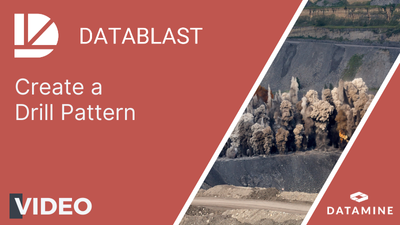Drill Pattern Design
The drill pattern is the core pattern type for drilling management. All holes must belong to a drill pattern. A hole cannot belong to more than one drill pattern.
To create a drill pattern, you need to define at least four surfaces:
- Collar Surface—The top of the hole (that is, the hole collar) is represented by the topography of the landform.
- Excavation Surface—The target for excavation after blasting. The vertical distance from the collar surface to the excavation surface is the target bench height.
- Drill Toe Surface—The toe of the hole is where you plan to drill to. If the drill toe surface is below the excavation surface, the difference is called 'overdrill'. If the drill toe surface is above the excavation surface, the difference is called 'standoff'. For diagrams of these concepts, see Holes.
- Pattern Anchor Surface—Sometimes called the 'design surface', this is the surface from which DataBlast Ignite designs the collar and toes of holes. The recommended pattern anchor surface is a flat plane at a specified relative level (RL). The collar is projected up from the design point and the toe is projected down from the design point. Using a pattern anchor surface means that holes can be evenly spaced, even if the collar surface is on undulating or uneven ground. The points on the pattern anchor surface can also be considered as the 'pivot points'. If you move one of these pivot points, DataBlast Ignite recalculates the collar and toe. If you change the angle of a hole, DataBlast Ignite recalculates the collar and toe based on a vector that passes through the anchor point at the new angle. The pattern anchor surface can be one of the other surfaces. For example, if you prefer a 'toe-up' design, set the pattern anchor surface to be the same as the excavation surface.
- Charge Toe Surface—(Optional) For a situation where you do not want to load explosives at the bottom of the hole (for example, where the drill toe is just above a coal seam), you can define a charging surface. DataBlast Ignite calculates the required length and volume of aggregate to be loaded into the bottom of each hole below the explosives.
Note: You can assign the drill toe surface and/or the charge toe surface to be the same as the excavation surface. Use this scenario if you plan to add subdrilling manually; for example, if your mine has different subdrilling values between rows.
However, an alternative (and simpler) method is to define fixed targets for the collar, toe and projection style.
See also Patterns and Pattern Properties.
This video, recorded using an earlier version of DataBlast Pro, provides an example of how to create a drill pattern.


